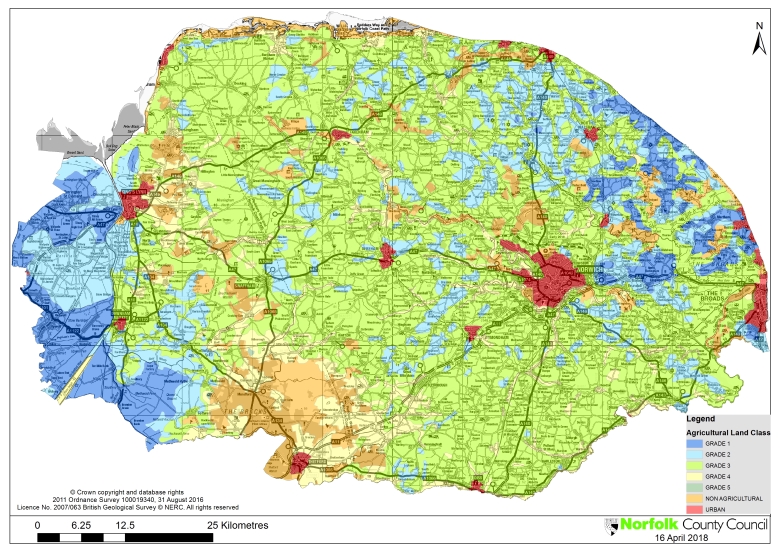Minerals and Waste Local Plan: Pre-Submission Publication
10. Agricultural soils
10.1 Norfolk is predominately rural in nature and agriculture plays a significant role in the local economy and heritage. Continuing to preserve good quality agricultural land is important as it will benefit the economy as well as Norfolk's landscape. Agricultural land is divided into five grades as follows:
Grade 1 – excellent quality
Grade 2 – very good quality
Grade 3 – good to moderate quality
Sub-grade 3a – good quality
Sub-grade 3b – moderate quality
Grade 4 – poor quality
Grade 5 – very poor quality
10.2 The Best and Most Versatile (BMV) Agricultural Land consists of grades 1, 2 and 3a. The NPPF states that "where significant development of agricultural land is demonstrated to be necessary, areas of poorer quality land should be preferred to those of a higher quality". However, minerals development is, in almost all cases, a temporary use of land, followed by restoration. It is therefore normally possible to remove and store topsoils and subsoils during an operational phase, and then to replace them afterwards to bring a site back into agricultural use, if appropriate.
10.3 Grade 1 soils are a vital national resource and Norfolk contains some significant areas of Grade 1 land, particularly in the peaty soils of the Fenland area and the Broads. Grade 2 soils are distributed more widely across the county, albeit in smaller patches, but Grade 3 soils make up the majority of Norfolk's agricultural land. The subgrades of 3a and 3b agricultural land are not mapped, at a national level, and therefore it is only possible to differentiate between them by carrying out a detailed site survey of soil quality. It is only as surveys on individual landholdings are carried out that 3a and 3b are differentiated. Grade 4 land occurs in smaller areas, located mainly in the drier and more free-draining Brecks. There are only 110 hectares of Grade 5 agricultural land in Norfolk which is all located either within or adjacent to the Breckland SPA, therefore there is no policy preference for locating minerals or waste development on Norfolk's Grade 5 agricultural land.
10.4 As detailed in Policy WP3, waste management facilities should be suitably located on previously developed land or on land allocated or permitted for general industrial use or storage and distribution use. Therefore, it is not normally appropriate to locate waste management facilities on agricultural land. However, where a waste management facility is proposed on BMV agricultural land, policy MW5 will still apply.
Policy MW5: Agricultural soils
Where development is proposed on agricultural land, the County Council has a clear preference for locating new mineral extraction and associated activities, and composting facilities, on land of agricultural grades 3b and 4.
Development proposals affecting Grade 1 agricultural land will only be permitted in exceptional circumstances, where it is demonstrated that there are no alternative locations for the development.
In addition to the above, when minerals development, particularly extraction, is proposed on agricultural land of grades 1, 2 or 3a it will only be permitted where:
- Provision is made for high standards of soil management that would enable restoration to a condition at least as good as its previous agricultural quality. To demonstrate this, soil and land quality surveys, and soil handling and replacement strategies (based upon Defra's 'Good Practice Guide for Handling Soils') must be submitted to the County Planning Authority; or
- The benefit of restoring the land to another after-use can be shown to outweigh the loss of the agricultural use of the land.

